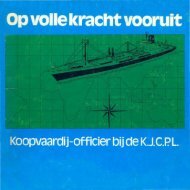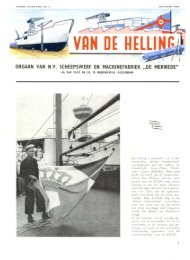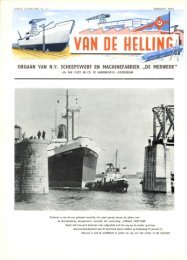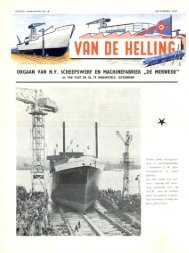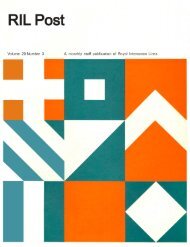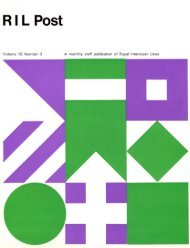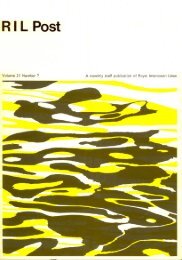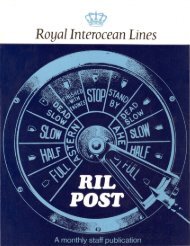straat towa - Varen Is Fijner
straat towa - Varen Is Fijner
straat towa - Varen Is Fijner
Create successful ePaper yourself
Turn your PDF publications into a flip-book with our unique Google optimized e-Paper software.
•• •<br />
A MONTHLY PUBL ICATION<br />
FOR ALL PERSONNEL OF THE<br />
Vol. XIII. No. 10 . October, 1966
WELCOME<br />
"STRAAT TOWA"<br />
"This Owl Watches Ahead" is the mnemonic of the<br />
Towa, the 11,000 d .w.t. vessel which Royal Interocean<br />
Lines have recently purchased from Messrs. N.V.<br />
Maatschappij Vrachtvaart.<br />
m.v. Towa was built in 1957 by P. Smit Jr .. Rotterdam.<br />
She then entered the services ol the N.V. Havenlijn<br />
183<br />
operating between Bremen, Hamburg, Antwerp end<br />
Rotterdam and ports on the East Coast ol South<br />
America.<br />
Her appearance is cha raderized by a well-raked bow,<br />
streamlined amidships deckhouse end 3 masts. The<br />
engine room is situated amiclships, end the vessel hes 2<br />
continuous decks with a third deck fitted in the Nos. I,<br />
2 and 3 holds.<br />
The Towa has 5 cargo holds served by 5 hatchways,<br />
with lour deep tanks in No. 3 hold. All cargo holds<br />
are fitted for the carriage of grein ca rg o end all are<br />
mechanically ventilated.<br />
She is equipped with 19 derricks - +welve 6-ton derricks,<br />
six I S-ton derricks end one heavy derrick with a hoisting<br />
capacity ol 65 tons. The latter is litted to the loremast<br />
and serves No. 2 hold. The derricks are served by<br />
electric cargo winches.<br />
There is accommodation for 12 passengers end all<br />
accommodation, both for passengers, officers and crew ,<br />
is fully air-conditioned.<br />
m.v. Towa is powered by an 8-cylinder B. & W. engine<br />
(type 874 VTBF-160). The maximum continuous output<br />
ol the ma in engine is 10,000 s.h.p. at I 15 r.p.m .. which<br />
gives the ship a speed ol 17 knots. Eleclricity lor power<br />
and lighting is supplied by lour generator sets, each<br />
consisting ol 5-cylinder. 4-slroke B. & W. engines (type<br />
25 MTHUO - 250 HP) coupled to Thrige generators<br />
supplying 165 KW O.C. at 220 volts.<br />
It has been decided to rename the vessel 'Straat Towa',<br />
in keepjng with the Company's policy of naming ships<br />
af ter Straits in the area served by RIL vessels. T owa is<br />
a small island in the Indonesian Archipelago near Ceram.<br />
Her principal particulars are as follows:<br />
L.O.A. -489'-9*,' 149.281 M.<br />
L.B.P. -455'-0" 138.681 M.<br />
Breadth - 63'-0" 19.202 M.<br />
Depth to shelterdeck- 39'-10" 12.141 M.<br />
Balespace - 591.291 cu. ft.<br />
Deadweight at<br />
Summerdraught - (27' -6t") - I 1,030 T @ 1016 kg.<br />
Fuel Capacity - 1629.1 M' = 1394.2 tons (S.G. 0.87)<br />
Gross Tonnage 6854.46 R.Ts.<br />
Nett Tonnage 3769.62 R.Ts.
IN BLACK<br />
THE 'WHITE SISTERS' BLACK; THE 'RUYS' WHITE.<br />
Far a moment one wonders jf one's eyes are playing<br />
tricks , but the camera does not lie.<br />
The above picture ol the Tjiluwah and Tjiwangi at<br />
Hong Kong was taken on June 27th, 1958 on the first<br />
occasion when the sisterships were berthed simultaneously<br />
in Hang Kong harbour. The vessels at that time we re<br />
plying between Hong Kong and Indonesia in the Hong<br />
Kong-Singapore-Indonesia Service (HSIS). It is also<br />
interesting to note from this pho+ograph the sparselyscattered<br />
buildings on Hang Kong <strong>Is</strong>land and to realize<br />
how much th is view has changed over the past 8 yea rs.<br />
The Tjiwangi and Tjiluwah were built in 1950 and<br />
1951 respedively at C. van der Giessen en Zonen's<br />
Scheepswerven N.V" Krimpen a/ d Ijssel. Holland. The<br />
Tjiwangi underwen+ her 'face lift' during drydock maintenance<br />
in Hang Kong between December 1962 and<br />
February 1963 end Tjiluwah between January and March<br />
1963.<br />
The naw 'White Sisters' are particularly famous in<br />
Austra\ia. which they have been visiting monthly on the<br />
AJHAS schedule service since its commencement in<br />
1960.<br />
184<br />
The photograph ol the Ruys opposite also presents some·<br />
thing ol a mystery. The ship was bui lt in 1938 at<br />
N.V. Koninklijke Maatschappij, 'De Schelde', Vlissingen ,<br />
Holland , a year af ter the Boissevain and the same year<br />
as the Tegelberg, which were built at different shipyards.<br />
Initially all three ships we re white. They were taken over<br />
simultaneously from K.P.M. in 1947 when part ol the<br />
K.P.M. fleet was incorporated in the J .C.J .L. to lorm<br />
the Java-China-Paketvaart Lijnen . In December 1947,<br />
Her Majesty Queen Wilhelmina bestowed on the Com·<br />
pany the prelix 'Kon ink lijke' and shortly afterwards the<br />
trade name 'Royal lnterocean Lines' was adopted. The<br />
Ruys in th is photograph is still in K.P.M. colours.<br />
We received this photograph ol the Ruys Irom Mr A.J.<br />
Dijkstra in Johannesburg, who tells us that a Iramed<br />
enlargement is hanging in the RIL office there. H ow+<br />
ever, he does not know exactly when or where it was<br />
taken .<br />
Would anyone be kind enough to let us know?
All through the summer the vines are tested, sprayed<br />
end prepared for the picking season which commences<br />
in February. With the arrival ol the lirst trucks bearing<br />
barrel-Ioads ol grapes, nature bows out, end all the skill<br />
ol the wine-grower is ca lied into play. The lirst stage<br />
of the winemaking process is pressing. Nobody now<br />
uses the ancient bareloot method, but Keith Tulloch, a<br />
Hunter Velley expert, hes a German-designed pneumatic<br />
press which he says is every bit as good. Pu lp end skins<br />
coma away unbruised end seeds remDÎn intact.<br />
It is important to treat grapes gently, otherwise flavour<br />
may be impaired and much of the flavour end colour<br />
of red wine is derived from the skin . "In producing<br />
white wines" . Tu lloch eXplained, "the grapes dre pressed<br />
within en hour of picking to extract the juice as quickly<br />
as possible. The skins are ploughed back into the soil.<br />
The reds we treat differently, skins accompanying the<br />
juice into the fermentation vats",<br />
Wine does. in a sense, make itself. If you simply press<br />
the grapes end let the juice stand , its sugars will do<br />
the rest. Frequently, it does a creditable job, but there<br />
are times when the result can be only described, and<br />
not without a shudder, as a deplorable example ol<br />
unskilled labour. Over the centuries, the process has<br />
been refined until it has become high art.<br />
Fermentation poses another problem; it creates heat<br />
which, il aggravated by hot summer weather, is likely<br />
to upset the process, and result in poor quality wine.<br />
50 a close watch must be kept on temperature. For<br />
some of the valley's do-it-yourself winemakers, this is a<br />
crucial period.<br />
Temperature is difficult to control in on open vat when<br />
you have hundreds ol gallons bubbling and churning.<br />
One way of doing it is to drop ice into the vats; but<br />
the development of stainless steel has made workable<br />
a more scientific method.<br />
189<br />
ViQneron Keith Tulloch kups " constant check on the fl,,\lour. cotour oIInd<br />
rate of ageing of his win". Here he draws off some ne ... wine with a · ... ine<br />
Ihief' from Ihe top of ol! 500 gation \lal .<br />
Af ter the bubbles cease , the 'must' is run off into storage<br />
where fermentation is completed. Some white wines go<br />
into casks to gain flavour, others into steel containers<br />
which preserve their freshness and bouquet. The reds,<br />
needing long life in the wood to mature in flavour and<br />
bouquet, repose in huge 500-gallon casks lor upwards<br />
ol I 8 months.<br />
Finally, the wine is bottled and removed to the cellars.<br />
And now, all that remains is to put the wine to the<br />
test - Pokolbin Dry Red and Pokolbin Riesling. Ah ,<br />
yes! It's a happy product they make in Hunter Valley.<br />
(By kind perm issio n of 'Wo lkobout', Austr"I;,, )<br />
Th. \linlaQe is 0\1", the ne ...... ine h made. Some ol der bolll" are pulled<br />
out of d"rk corners "nd the new \linlage is celebrated.
" I am still fit lor a bit ol wo rk" - Mr de Haan quoted<br />
Mr Jeremiasse's own words as he addressed a luncheon<br />
party at HK HO on August 19th. After a grand total<br />
of over 36 years. Mr C.W. Jeremiass9, Superintendent<br />
Engineer since 1957. hos retired Irom Ihe Company.<br />
Mr de Haan continued by saying that although il<br />
was a pity to say goodbye to a person with 50 much<br />
experience, nowadays it is no langer necessary for a<br />
man to "die in his working harness" , end Mr Jeremiasse<br />
could look lorword to an enjoyable private lile.<br />
He arrived in Indonesia in 1930 to join KPM as a 5th<br />
Engineer. 1937 brought him promotion to 4th Engineer<br />
end during the war years he served on the troopship<br />
Boissevain . 1+ was then that Mr Jeremiasse met his wife<br />
Margaret end they married in Glasgow in 1943. Her<br />
nationality later made her a graat help to him as<br />
Superintendent Engineer, as a great proportion of paaple<br />
on the Hang Kong Dockyard scene are Scottish.<br />
In 1946, newly promoted 3rd Engineer Jeremiasse went<br />
on home leave and returned to serve on mv. Tegelberg,<br />
ss. Karsik and mv. Straat Malakka. His study leave in<br />
Holland in 1948 was lollowed shortly alterwards by<br />
lurther promotion 10 2nd Engineer and in July 1954 to<br />
Chief Engineer. The same year Mr Jeremiasse was<br />
posted Irom ship 10 shore. to the position ol Adj. Chel<br />
in the Technical Deparlmenl at HK HO and in 1958,<br />
to Chef van Dienst.<br />
During his years as Superintendent he maintained a<br />
keen interest in the maintenance of our ships. He was<br />
renowned throughout the f1eet for his tremendous knowledge<br />
and experience and was said to know every inch<br />
GOODBYE " UNCL.E KEES"<br />
194<br />
of every engine room in every ship. He could track<br />
down any technical faults or selve technical diffjculties<br />
with amazing aptitude. Newly built ships were always<br />
improved through quick application of his years of<br />
experience.<br />
The speaker concluded by wishing Mr Jeremi.asse, his<br />
wifs and family every happiness and success for thei r<br />
retirement in Australia.<br />
In reply, Mr Jeremiasse thanked Mr de Haan lor his<br />
appreciative words, adding that hè had loved his work<br />
both at sea and ashore . While it is painful to say<br />
goodbye 10 something one loves, he will slill be ab Ie<br />
to make use of his trade, end was looking forward to<br />
being re-united with his wife and family.<br />
He Ihen proposed a toa si 10 all R.I.L. personnel wherever<br />
Ihey may beo wishing Ihem all the best lor the luture.<br />
The engineering stall ol the RIL Fleet bade their larewell<br />
to Mr Jeremiasse at a cocktail party held on mv Tjiluwah<br />
on 17th August.<br />
On th is occasion, Chief Engineer G.H. Menses recalled<br />
the good understanding between shore and sea-going<br />
slall which had always been promoted by Mr Jeremiasse<br />
ond expressed the appreciation ol the fleet lor the<br />
generous hospitality which had always been exlended<br />
to the ships' engineers whenever they were in Hong<br />
Kong. In this connection he mentioned particularly Mrs<br />
Jeremiasse and thanked her on behall ol the fleet lor<br />
her kindness and interest.<br />
He then made a presentation to Mr Jeremiasse on<br />
behall ol the Engineering Stall of Ihe RIL Fleel and<br />
concluded by expressing the hope that he and his lamily<br />
might enjoy these presents for a long time and by<br />
wishing them a happy retirement.<br />
Presentations were also made by the senior staff of HK<br />
HO and by the slall of the Technical Department.<br />
On board m.v. Tjiluwah , ehief Engineer G.H. Menses makes a<br />
presentation to M r Jeremiosse on behaH of all the Eng ineering<br />
Staff of the R.I.L· Fleet.
Nigerian N ational Shipping Line Ltd . was recently<br />
appointed the R.I.L. Agent lor Lagosj Apapa.<br />
A cocktail party was held on July ISth at the Federal<br />
Palace Hotel, Lagos to ma rk the occasion. The Holland<br />
West-Afrika Li in N.V. also t ransferred their Agency to<br />
the Nigerian National Shipping Line Ltd. on the same<br />
date.<br />
Pidured above, Irom I. to r.: Mr. van der Goes (Ading<br />
General Manager for West Afriea ol H.W.A.L.), Mr.<br />
Oloriokuma (Chai rman N.N.S.L.), Mrs. Sinninghe Damsté,<br />
Mrs. van der G oes, Mr. Omenai (Permanent Secretary of<br />
the Ministry ol Transport), Mr. Oyesiku (General Manager<br />
N.N.5.L.).<br />
Right, I. to r.: Mr. Oloriokuma . Mr. Chukwurah (Assistant<br />
Manager (Steil) ol N.N.S.L.). Mr. Oyesiku.<br />
OPEN LETTER Ta ALL SEAGOING ENGINEERS OF R.I.L.<br />
Gentleme n,<br />
August 17th 1966 will "Iw"ys re m" in " memor"ble d"y for me,<br />
b e c"use on that day t w"s inv ited on board our ms. TJILUWAH<br />
to receive same beaut iful presenh from you, th e seagoing staff<br />
of Royal Interoce"n Lines, on the occasion of my re tire me nt from<br />
the Comp"ny.<br />
Needleu to say I was deeply touche d and I wish to express my<br />
heartfelt thanh to everybody concern e d for this spontllne o us token<br />
o f lIpprecilltion for my work as Supe rinte nde nt Enginee r of our<br />
Company.<br />
I know that I shall get loh of p leasure out of th e T.V. se t, golf<br />
clubs. fishing geM and jade ornament and th ese presents will lllw" ys<br />
re mind me of th e p re" sent rel"tionship between us , end th e good<br />
yea rs in Hang Kong .<br />
It seems only fitti ng that my family - especially my wifc (who ioins<br />
me in thanking you all) - wiU share in th is pleasure since she has<br />
shared the ye"rs in Hang Kong ..... ith me as a tru e companion.<br />
195<br />
LAGOSJAPAPA<br />
TRANSFER OF AGENCY<br />
N ow th at th e t ime has come for me to hand over my work to a<br />
younger man it g ives me great sat isfaction to know t hat, as Chief<br />
Eng ineer Me nses p ut it, "the Eng ineers o n board our ships think<br />
sa weil of me".<br />
I wish to thank you all for your co-ope ration and help without<br />
which, o f course, I could not have done my jo b in " satisfactory<br />
manner.<br />
I hope thllt, ..... it h my successar "t th e helm of th e Eng ineering<br />
De partment , th e friendly relationshi p between th e Techn ical staR'<br />
ashore and o n board wilt be ma intained and t hat all shi ps wiJl run<br />
froublefree in th e yeMs to come .<br />
I tr ust 1 will see many of you again "down under" and wish you<br />
all "behouden vaart en goe de wacht" .<br />
August 1966<br />
C. w. IrremiolSe



